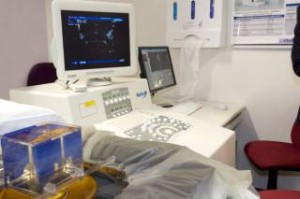NIHR funded doctors, surgeons and scientists from the HIFU Unit (high intensity focused ultrasound), marked its official opening at the Churchill Hospital after a 10 year collaboration with the Haifu Company of China.

The £1.5m Oxford HIFU machine has been given on long-term loan from the Haifu Company and was recently used to treat 72 year old David Atwell, from Oxford, a retired Managing Director in the food industry. Mr Atwell was diagnosed with a slow growing malignant kidney tumour in 2010. In July of this year he took part in a clinical trial to test the effectiveness of the procedure and within several days was back to his usual routine of four games of tennis a week.
HIFU uses an ultrasound beam at 10,000 times the strength of imaging ultrasound, which passes harmlessly through living tissue and at the focal point the temperature rises to kill the diseased tissue. This can be achieved to a high degree of accuracy, without damaging surrounding or overlying tissues. This ability to cause targeted cell death in tissue at a distance from the ultrasound source makes HIFU an extremely attractive option for development as a non-invasive surgical tool.

Mr David Cranston, Clinical Director of HIFU Unit and his colleague Professor Wu, one of the inventors of the HIFU machine in China, have been working for the last ten years with doctors, surgeons and scientists from the Oxford University Hospitals and the University of Oxford to evaluate the effectiveness of treating tumour types such as: liver (ablation of primaries and metastases), kidney tumours, prostate cancer, musculoskeletal (soft tissue and osteosarcoma), gynaecological (uterine fibroids), and pancreas (pain palliation).
The obvious benefits of HIFU over existing forms of cancer treatment is that HIFU is non-invasive (so no surgical incision with its associated risk of infection or long post-operative rehabilitation) and non-ionising (so no limit to maximum dose, and can be repeated as often as necessary). The advantages for patients are that their life is back to normal much more quickly with none of the side effects of drug therapy and they have no unsightly scars.